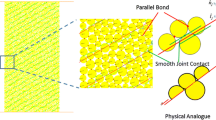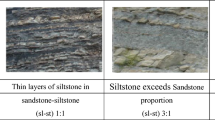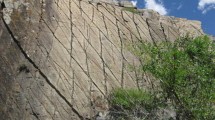Abstract
The failure mechanisms of non-persistent jointed rocks are crucial in understanding rock mass behaviour. This paper investigates the relationship between the tensile and frictional strength of jointed rock samples numerically and compares that with the results of previous laboratory-tested samples using two strength criteria. The first criterion assumes that tensile failure reduces shear strength parameters to their residual values, which is dependent behavior (Model 1). The second criterion assumes that tensile failure will not cause the shear strength parameters to be reduced to their residual values, which is independent behavior (Model 2). This numerical model uses the Mohr–Coulomb criterion with cohesion, friction, and tensile strength cut-off parameters, as tested in the laboratory. These artificial rock samples contain open joints with the same inclination but with different bridge inclinations of 45°, 60°, and 75°. The samples were tested in the laboratory until failure while monitoring displacement and rupture development. As the stress concentration increased, curvilinear yielding (wing crack) started near or at the joint tips and propagated and stopped or coalesced to form a continuous rupture surface. The numerical model showed that tensile stress caused wing crack initiation due to stress flow around the open joints. When using Model 2 as compared to Model 1, there was a strong and significant agreement between the laboratory tests and the numerical models in terms of the yielding path, width of the failure zone, and the uniaxial strength. The results indicate that tensile yielding should not affect the shear strength parameters.


























Similar content being viewed by others
Data Availability
Enquiries about data availability should be directed to the authors.
References
Alzo’ubi AK (2001) Fracture mechanisms of open offset rock joints under uniaxial loading, M. Sc. thesis, Jordan University of Science and Technology, Irbid, Jordan
Alzo’ubi AK (2012) Modeling of rocks under direct shear loading by using discrete element method. AHU J Eng Appl Sci 4(2)
Alzo’ubi (2016a) Rock slopes processes and recommended methods for analysis. Int J Geomate 11:2520–2527. https://doi.org/10.21660/2016.25.34052
Alzo’ubi AK (2016b) Modeling yield propagation of jointed synthetic rocks. In Rock Mechanics and Rock Engineering: From the Past to the Future-Ulusay et al (Eds), CRC Press: Taylor & Francis Group, London, ISBN 978-1-138-03265-1, pp. 113-118, v1, Proceeding of the 2016 ISRM International Symposium, EUROCK 2016, CAPPADOCIA, TURKEY, 29-31 AUGUST, 2016
Alzo’ubi AK, Martin CD, Cruden DM (2007) A discrete element damage model for rock slopes. 1st Canada-U.S. Rock Mechanics Symposium, June 2007, In Rock Mechanics, Meeting Society’s Challenges and Demands, edited by E. Eberhardt, D. Stead, and T. Morrison, vol. 1, pp. 503–510. Vancouver, B.C
Bahaaddini M, Hagan P, Mitra R, Hebblewhite BK (2016) Numerical study of the mechanical behavior of nonpersistent jointed rock masses. Int J Geomech 16(1)
Bobet A, Einstein H (1998) Fracture coalescence in rock-type materials under uniaxial and biaxial compression. Int J Rock Mech Min Sci 35:863–888
Bu F, Xue L, Zhai M et al (2022) Numerical investigation of the scale effects of rock bridges. Rock Mech Rock Eng 55:5671–5685. https://doi.org/10.1007/s00603-022-02952-2
Cho N, Martin CD, Sego DC (2007) A clumped particle model for rock. Int J Rock Mech Min Sci 44(7):997–1010. https://doi.org/10.1016/j.ijrmms.2007.02.002
Cho N, Martin C, Sego D (2008) Development of a shear zone in brittle rock subjected to direct shear. Int J Rock Mech Min Sci. https://doi.org/10.1016/j.ijrmms.2008.01.019
Einstein H, Venezaino D, Baecher G, O’reilly K (1983) The effect of discontinuity persistence on rock slope stability. Int J Rock Mech Min Sci Geomech Abstr 20(5):227–236
Elmo D, Stead D, Yang B, Marcato G, Borgatti L (2021) A new approach to characterise the impact of rock bridges in stability analysis. Rock Mech Rock Eng 1:1–19. https://doi.org/10.1007/s00603-021-02488-x
Guerin A, Jaboyedoff M, Collins BD et al (2019) Detection of rock bridges by infrared thermal imaging and modeling. Sci Rep 9:13138. https://doi.org/10.1038/s41598-019-49336-1
Hajiabdolmajid V, Kaiser PK, Martin CD (2002) Modelling brittle failure of rock. Int J Rock Mech Min Sci 39(6):731–741
Hajiabdolmajid V, Kaiser P, Martin C (2003) Mobilized strength components in brittle failure of rock. Geotechnique 53:327–336
Horii H, Nemat-Nasser S (1985) Elastic fields of interacting inhomogeneities. Int J Solid Struct 21:731–745
Ingraffea AR, Heuze FE (1980) Finite element models for rock fracture mechanics. Int J Numer Anal Method géomat 4(1):25-43
Jennings J (1970) A mathematical theory for calculation of the stability of slopes in open cast mines. In: Planning of open pit mines, p. 87–102. Johannesburg
Ladanyi B, Archambault G (1980) Direct and indirect determination of shear strength of rock mass. In Preprint Number 80–25, AIME Annual Meeting. Littleton: Society of Mining Engineering of A.I.M.E., Las Vegas, Nevada
Lajtai E (1969a) Mechanics of second order faults and tension gashes. Geol Soc Am Bull 80:2253–2272
Lajtai E (1969b) Strength of discontinuous rocks in direct shear. Geotechnique 6:499–515
Lajtai E (1974) Brittle fracture in compression. Int J Fract 10(4):525–536
Lin H, Ding X, Yong R, Xu W, Du S (2019) Effect of non-persistent joints distribution on shear behavior. Comptes Rendus Mécanique 347(6):477–489. https://doi.org/10.1016/j.crme.2019.05.001
Mughieda O, Alzo’ubi A (2004) Fracture mechanisms of offset rock joints-a laboratory investigation. Geotech Geol Eng 22:545–562
Mughieda O, Omar MT (2008) Stress analysis for rock mass failure with offset joint. Geotech Geol Eng. https://doi.org/10.1007/s10706-008-9188-1
Reyes O, Einstein HH (1990) Stochastic and centrifuge modeling of jointed rock, Part I-fracturing of jointed rock, Final Report submitted to the Air Force Office of Scientific Research and Air Force Engineering Services Center, USA
Rocscience (2016) Rocscience Software products, DIPS, SWEDGE, SLIDE and PHASE2. Rocsience Inc., Toronto
RS2 (2018) Rocscience Software products, DIPS, SWEDGE, SLIDE, and RS2. Rocsience Inc, Toronto
Sagong M, Bobet A (2002) Coalescence of multiple flaws in a rock-model material in uniaxial compression. Int J Rock Mech Min Sci 39(2):229–241
Shen B, Stephanson O, Einstein HH, Ghahreman B (1995) Coalescence of fractures under shear stresses in experiments. J Geophys Res 100:5975–5990
Stavrou A, Vazaios I, Murphy W, Vlachopoulos N (2019) Refned approaches for estimating the strength of rock blocks. Geotech Geol Eng 37(6):5409–5439. https://doi.org/10.1007/s10706-019-00989-9
Terzaghi K (1962) Stability of steep slopes on hard unweathered rock. Geotechnique 12:251–270
Zare S, Karimi-Nasab S, Jalalifar H (2021) Analysis and determination of the behavioral mechanism of rock bridges using experimental and numerical modeling of non-persistent rock joints. Int J Rock Mech Min Sci 141:104714. https://doi.org/10.1016/j.ijrmms.2021.104714
Acknowledgements
The authors would like to acknowledge the support of Abu Dhabi University and specifically the ORSP office for their financial contribution to the success of this research (19300604, 19300616).
Funding
The authors have not disclosed any funding.
Author information
Authors and Affiliations
Corresponding author
Ethics declarations
Competing interests
The authors have not disclosed any competing interests.
Additional information
Publisher's Note
Springer Nature remains neutral with regard to jurisdictional claims in published maps and institutional affiliations.
Rights and permissions
Springer Nature or its licensor (e.g. a society or other partner) holds exclusive rights to this article under a publishing agreement with the author(s) or other rightsholder(s); author self-archiving of the accepted manuscript version of this article is solely governed by the terms of such publishing agreement and applicable law.
About this article
Cite this article
Alzo’ubi, A.K., Mughieda, O.S. & Kewalramani, M. Modeling of Independent Versus Dependent Tensile–Frictional Strength Behavior of Jointed Rocks. Geotech Geol Eng 41, 3037–3056 (2023). https://doi.org/10.1007/s10706-023-02443-3
Received:
Accepted:
Published:
Issue Date:
DOI: https://doi.org/10.1007/s10706-023-02443-3




